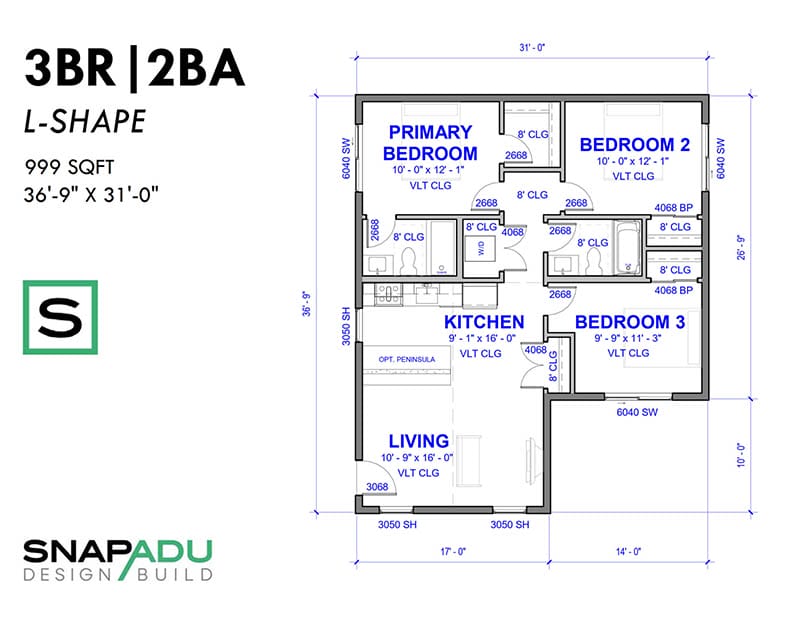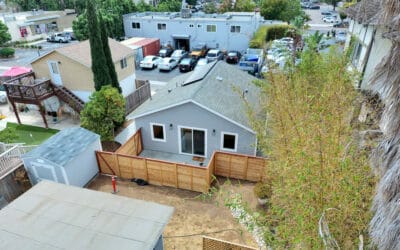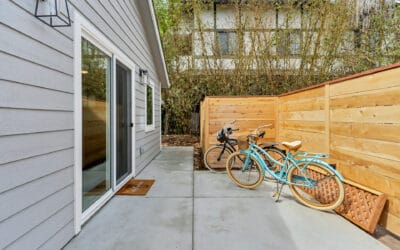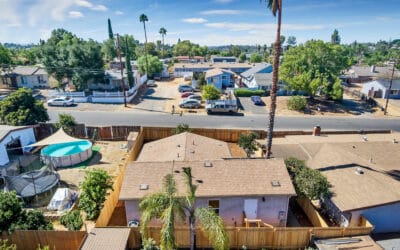Granny flats have exploded in popularity recently, thanks to the potential income and additional space they offer homeowners. Unfortunately, the process of building these structures can be more difficult under the watchful eye of your HOA. One of the biggest questions looming over property owners is whether or not their HOA will prevent an ADU from being built on their property in Greater San Diego. The short answer is no, but read on to learn why and how to get an ADU approved in an HOA.
Does my HOA allow ADUs?
Thanks to recent California legislation, homeowners no longer need to be concerned about their Homeowners Association (HOA) inhibiting their ADU projects. Before this change, HOAs could either directly restrict ADU constructions via the homeowner’s Covenants, Conditions & Restrictions (CC&Rs) or indirectly make the process prohibitively expensive and time-consuming.
However, the new ADU law now renders any HOA stipulations that effectively block or unreasonably limit the construction or use of an accessory dwelling unit (ADU) or junior accessory dwelling unit (JADU) on single-family residential-zoned lots as invalid. Consequently, your HOA can’t create undue obstacles that prevent you from building your ADU.
Video: Two Story ADU in an HOA in San Diego, California
Can an HOA or CC&R prevent me from building an ADU?
No, the HOA cannot prevent you from building an ADU. The California Housing and Community Development Department (HCD) has stated, “Specifically, CC&Rs that either effectively prohibit or unreasonably restrict the construction or use of an ADU or JADU on such lots are void and unenforceable (Civ. Code § 4751). HOAs of subdivisions or tracts outside of planned developments may not enforce CC&Rs and operating rules “contained in any deed, contract, security instrument, or other instrument affecting the transfer or sale of real property that either effectively prohibits or unreasonably restricts” ADUs and JADUs that comply with State ADU Laws. (Civ. Code § 714.3).”
Further from the HCD, “While Associations may impose more subjective standards on an ADU or JADU than local agencies per se, such as materials, architectural styles, or other subjective aesthetic standards, those standards must not extinguish the ability to otherwise create an ADU according to local ordinance or State ADU Law (Gov Code, § 65852.2, subds. (a)(1)(B), (a)(3)(A) and (e)(1); § 65852.22, subd, (a)(1); Civ. Code, §714.3).”
How do you get an ADU approved with an HOA?
Your ADU will still need HOA approval, and you will need to understand any design requirements or restrictions. For instance, cities such as Poway and Rancho Santa Fe have requirements that the architectural features of the ADU must match the main house. We can quote out any upgrades this might entail, for instance upgrading to a tile roof or board and batten siding.
Luckily, the set of architectural plans that are submitted to the city for building approval will be the same set you submit to the HOA, which makes the whole process a bit more efficient. There are two ways of going about plan submission:
- Submit plans concurrently to your HOA and to the municipality. This approach does risk the HOA requesting changes that we then have to amend to match the city-submitted set. Most cities will require a number of revisions before a permit is issued, as well, which may also alter your HOA’s approval of your plans should the change throughout the process. These changes can draw out the build process quite a bit.
- Submit plans sequentially, first to the HOA then to the city. This approach would allow you to get feedback from the HOA and incorporate ahead of submission to the city. When going about approval sequentially, we can likely just submit the architectural plans and specifications, and not include the T24 and structural engineering the city will require, which can make the process less time consuming and more likely for positive feedback.
How does SnapADU handle HOA submissions?
Our approach is to prepare our Feasibility Report, which includes a site plan, floor plan, and elevations, which includes callouts on materials to be used (typically to match existing house). In some cases this is sufficient for the HOA. In other cases, they may require full construction drawings. We usually advise the client to submit to the HOA and for permits concurrently, and address any design changes called out by the HOA during the plan revision process that occurs with the municipality.
The best way to go about this approval process is finalize as many selections as possible before submitting to the HOA, as they are unlikely to request any structural plans. If this changes at any point, we will be able to make these changes in design and will be sure to keep you in the loop throughout the process. It usually takes about 30-45 days for an HOA to review the submitted plans and provide feedback, which will already be factored into the building process.
How long can an HOA take to review your ADU?
The HOA should respond in the same timeline as the city, so not more than 60 days to act on an application. Again from the HCD, “Associations that preempt or otherwise interfere in the permitting process at the local agency or require approval of an ADU after the permittee has obtained building permits are acting as a Permitting Agency. Therefore, such an application must be created or served pursuant to Government Code section 65852.2, subdivision (a)(3)(A) and must be approved or denied within the same 60-day timeline, with the same requirements to provide for approvals and denials, including but not limited to comments that would remedy the application’s denial, and an application being deemed approved if the agency fails to approve or deny within the specified timeframes.”
What if I own a condo and want to build an ADU in my portion of the property?
These are very sticky situations where it’s legally murky as to what is allowed. Legally you can build up to two ADUs on a multifamily parcel. The question is whether the other condo owners are also OK with it, since they likely collectively own the common spaces. Building an ADU would likely require the various owners in the HOA to authorize the ADU in the common area, unless there is something else written in the Covenants, Conditions & Restrictions (CCRs).
Can an HOA require story poles?
We have seen some instances where the HOA has requested installation of story poles. In reality, there is not much that a complaint by a neighbor can do, as state regulation regarding ADUs means that they are allowed in HOAs. In most cases clients have gone ahead and installed the story poles, as it was the cheapest and least time-intensive path… they are typically $2-4K to install.
From the HCD, “Unreasonable costs might include, but would not be limited to: substantial delays, re-applying for a building permits, re-payment of substantial fees for an ADU relative to the project’s final costs, requiring major structural elements that would extinguish the investment, or other considerable costs that would effectively prohibit by the forgoing of the ADU or JADU development from being constructed or leased, as declared by a property owner whose separate interest is impacted by the actions of an association or their representatives or agents.”
What are the ADU laws that affect HOAs?
AB 670 governs how HOAs can restrict accessory dwelling units. There are a few details to understand, including:
Reasonable Restrictions
Although ADUs cannot be restricted by an HOA, these associations are able to require certain modifications to your ADU. However, they are only allowed to impose reasonable restrictions. These restrictions should not add significant additional time or expense onto the ADU build, and the majority generally deal with the aesthetics of the unit. A common restriction HOAs will place onto an ADU is that the windows, stucco and roofing match those of the existing residence and adjacent homes within the development. We can of course provide an estimate for what these changes will cost to incorporate in your build.
Also, the HOA restrictions are voided if and only if the new structure meets the “minimum standards provisions” for a dwelling, as set forth under local zoning ordinances – which would include state laws for ADUs as well. So you would still be able to build up to an 850 sqft 1BR or a 1000 sqft 2BR+ at 4′ side and rear setbacks per state laws, regardless of the existing HOA restrictions.
Fortunately, these types of restrictions are common, and we’ve seen many scenarios play out so that we can guide you through the process.
Single-Family vs. Multi-Family
Another exception to the HOA rules mentioned above has to do with the type of residence you are looking to add an ADU onto. The legislation passed regarding HOAs primarily will affect single-family homes on property owned by the homeowner. However, homeowners who live in a multi-family home, such as a condominium where the HOA owns the common areas and property surrounding the home, may be prohibited from building an ADU adjacent to their unit.
The ADU laws are so new that we are often seeing cities interpret the code for the first time. For instance, legally you can build up to two ADUs on a multifamily parcel. However, it gets murky when condo owners collectively own the common spaces, such as open space that could potentially house an ADU. Building an ADU would likely require the various owners in the HOA to authorize the potential ADU in the common area, unless there is something else written in the Covenants, Conditions & Restrictions (CCRs).
HOAs cannot reasonably prevent ADUs from being built
Your HOA cannot stand in the way of your accessory dwelling unit. Reasonable restrictions may be placed on your ADU, but your ability to build is currently protected by California law. Although you should anticipate minor changes, we will walk you through the necessary amendments to ensure your build goes smoothly and you are pleased with the end result. Schedule a call to get in touch and discuss your property specifics.
Reach out to experts for your unique situation
The insights shared in this article stem from our vast expertise in the field, encompassing hands-on experience in design, development, and implementation. While we are committed to delivering accurate and current information, it’s crucial to recognize the dynamic nature of the ADU space, which may lead to changes that could affect the details covered in this blog.
SnapADU strives to empower our readers with valuable insights and practical knowledge to navigate the continually evolving landscape of accessory dwelling units. We invite you to connect with our experts for personalized guidance and to remain informed about the latest advancements in the field. By staying engaged with us, you can ensure that you’re equipped with the most up-to-date information to make informed decisions in your ADU journey.






Very recently, Governor Newsome signed AB 1033 that would allow selling ADU’s constructed on your single family home parcel. If HOA’s cannot restrict building ADU’s can they restrict selling the ADU’s once constructed? Also, how many units can you construct on your property?
For selling ADUs (condo mapping), first a local jurisdiction would need to pass an ordinance allowing this. Depending on the language used, HOAs may or may not have authority over this kind of decision.
For number of ADUs allowed on your property, it will depend on your zoning and jurisdiction. Single family properties may build one ADU and one JADU. Multi family may build two detached ADUs and convert existing non-habitable space. And in City of San Diego, you may be able to build bonus ADUs as well.